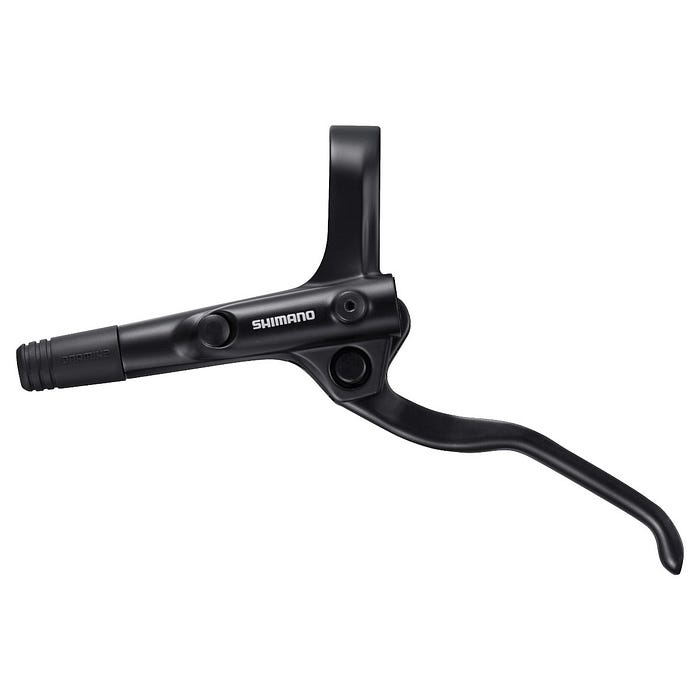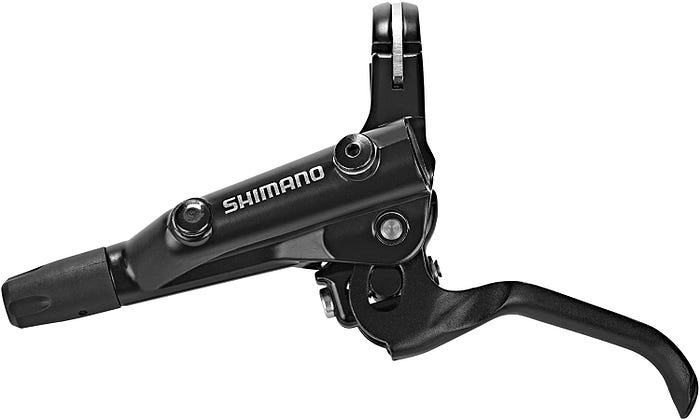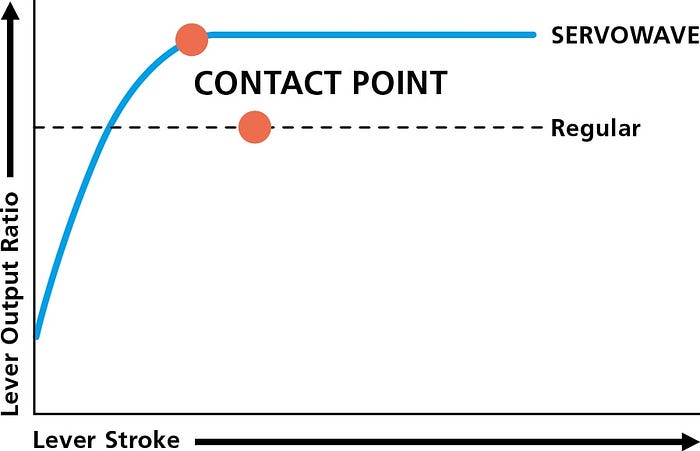Shimano MTB groupset differences
This article matches this one, for road bikes.
The concept of a groupset in MTB terms is quite different from road bikes. Typically a road bike will have matching Shimano rear and front derailleurs, cassette, chain, brakes and shifters.
While Shimano offers such a line-up for MTB, it doesn’t typically get specified as a full groupset, as manufacturers aim to save money, most commonly on brakes, but also on cranks and other components.
Brake calipers
Hydraulic disc brakes are available from Shimano at low cost. This means you will find them on most MTB and hybrid bikes.
However some hybrid bikes (bikes with flat bars) you will find Shimano v-brakes, which are high enough quality.
Although Shimano makes mechanical disc calipers, the lower cost of rival mechanical calipers, and low cost of their hydraulic calipers, means that you will not find Shimano mechanical disc calipers on virtually any bike.
Referring to Shimano’s disc brake calipers, the most common is MT200. There are numerous other brake calipers starting BR-M2, M3 and M4, and M5 and on the whole they aren’t an upgrade on the MT200, which will stop a bike very effectively.
Shimano considers the MT200 brakes to form part of a ‘Alivio’, ‘Acera’ AND ‘Altus’ specification. However they are extremely commonly specified on bikes with Deore shifters & derailleurs.
Two slightly different parts are the MT420 and MT520 calipers. These are four-piston designs, which are very similar to Shimano’s downhill MTB groupset. The difference between the MT420, MT520 and more expensive brake calipers is that they use a straight connection to the caliper, rather than a banjo joint as on more expensive brakes. This gives slightly worse heat dissipation. The MT420 caliper has resin pistons, rather than the ceramic on MT520 and all higher parts. The MT420 is likely to be specified on e-bikes, as it is often paired with levers intended for cargo bikes or similar, rather than mountain bikes, which typically have shorter
True ‘Deore’ brakes are usually only found on mountain bikes costing $2,000 and up. The major difference with these brakes is that the caliper uses a different pad, which does not go as deep into the rotor diameter, but spans more circumference. This difference allows Shimano to draw a distinction between cheaper rotors (those starting RT5 and below, e.g., SM-RT10, SM-RT30), which use softer steel and are not recommended for metal pads, presumably for abrasion reasons. In addition, the most expensive rotors are made of steel/aluminium/steel sandwich, which dissipates more heat. These rotors are deliberately incompatible with the pad used on the MT200 -MT500 calipers.
The Deore brake calipers from the current (M6100) and previous several generations (M6000, M615) have not changed much — they use two resin pistons and the newer pad design (though the M6100 hose routing is improved compared with previous generations). However, a new option is the M6120 4-piston caliper, which is identical to the MT520 caliper.
The SLX and Deore XT calipers are identical to each other, while the XTR one may be a few grams lighter, but functions the same. Comparing them to Deore, the difference is the use of the banjo joint to connect the caliper, while the 2-piston design also gets the addition of ceramic pistons (which are already on the Deore 4-piston calipers).
Brake levers
As mentioned the overwhelmingly most popular brake is MT200. The accompanying lever is MT200 (steel lever, which will rust) or MT201 (aluminium, which won’t). Obviously MT201 is better for being rustless.
The major feature of the MT200/MT201 is the long levers

Long levers, called ‘3-finger levers’ by Shimano are good for touring bikes, but for technical terrain, most prefer ‘1-finger braking’, which gives more control over the bike. This is more difficult with the long levers, as you will have to remove the levers from the bar, and move them inside the shift lever.
Deore brake levers, and most starting M4/MT4, will be ‘2-finger levers’, which are better

Note the shorter lever, and also that the levers can be removed from the bars by opening a clamp — it is not necessary to slide them off the bar.
The Deore and higher levers, plus M4100 and MT500/MT501, have Shimano’s ‘i-spec’. This is a feature which allows you to hang a shift lever off the brake lever, instead of attaching it to the bars. Unfortunately Shimano revise this very frequently, so there is rarely compatibility between generations. The latest ‘i-spec EV’, has different degrees which you can adjust rotation between brake and shift lever, which are Deore (10°), SLX/Deore XT (20°), and XTR (60°).
The other major feature on Deore (and also MT500/MT501) is the servo-wave feature, which reduces the braking force required to bring contact between pad and disc:

This feature is removed from the M9100 super-light-weight XTR brake levers, so it is not to everyone’s taste, but it’s generally considered an upgrade.
The SLX and XT levers are essentially identical, however the free stroke adjust screw is missing from SLX. This feature is not very popular with users, so this is not much of loss. Both levers also have toolless reach adjust, which isn’t too important.
The Deore and XT levers offer the same braking performance: the difference really comes in the lever adjustments. Note that an upgrade with Deore and higher brakes is the use of Shimano’s more rigid BH90 hose, rather than the softer BH59. Although the hoses are completely cross-compatible between any lever and caliper, it won’t cost much more to buy a full set of Deore brakes with hose, lever and calipers than just the hoses, so hoses aren’t something to upgrade on bikes on their own.
In conclusion your $1000 bike probably comes with MT200 and cheaper rotors, which are just fine, and it’s not too expensive to upgrade to Deore or maybe SLX — it’s not necessary to buy the $2000 bike just for the brake upgrade (though the $2000 bike will typically have suspension and other improvements as well).
Brake rotors
Shimano rotors are available in 140mm, 160mm, 180mm and 203mm sizes. Typically 140mm is only used on road bikes, 160mm is a ‘standard’ size, 180mm is a popular upgrade for bikes used in harder offroad conditions (sometimes 180mm front, 160mm rear), and 203mm is used for downhill MTBs. A bike with 160mm rotors can be switched to 180mm, though this will require an adapter for the caliper. Larger rotors provide more braking force.
There is a rating for the fork to describe the maximum rotor size; for example, a hybrid bike with carbon fork for road use probably will not be built for the forces generated by a 203mm rotor.
In addition to the size, Shimano have several tiers:
- RT10 is the standard grade
- RT30 is the all-stainless version (rust-free)
- RT54 saves 25g weight
- RT64 uses a different type of steel which metal pads won’t be quickly exhausted, as with lower types (note, resin pads are the default choice in most cases, so this isn’t a major issue).
- RT70 is ‘Icetech’, which has an aluminium core for heat dissipation
- MT800 is ‘Icetech Freeza’, which adds fins for more heat dissipation
- MT900 is the same as MT800 with a different finish. It is not lighter/better.
Typically MT200 brakes will be supplied with the RT10 rotors, which are just fine. Deore brakes may be supplied with RT54/RT64, SLX with RT70, and XT with MT800. However you can upgrade these after market.
Shifters
The shifters from Altus to XTR are all ‘Rapidfire’, which refers to the position of the shift levers. However there are differences in the implementation of this.
Shifters marked ST combine brake levers and shifters. The ‘EF’ type means ‘Easyfire’ (e.g., ST-EF505), which is a clunkier design.
The Shimano shifters have the following levels:
- Altus, Acera and Alivio — largely interchangeable. Note that for 2020/21 model year, Acera was renamed Alivio, so M3100 ‘Alivio’ is similar to M3000 ‘Acera’. If you find a bike with M4 Alivio, then it has ‘2-way release’, in which the release lever works in both directions (a feature found on higher shifters). In addition, the M4 series had levers that more closely resembled Deore. As components for beginners, these shifters will all come with gear indicators, while more expensive ones might not.
- Deore/Zee 10/11 speed shifters use a higher grade of plastic compared to Alivio/Altus/Acera. They also have ‘2-way release’.
- Deore 12-speed shifters have textured levers, a feature previously only on XT/Saint levers

- SLX shifters are almost identical to Deore, including the upgrade to textured levers for 12-speed (and not previously). However the position of the shifting lever can be adjusted, which is not a feature of Deore unless using i-spec.
- Deore XT (and Saint) shifters are substantially improved on SLX/Deore, in that they have higher-quality construction including an aluminium lever (rather than GFRP & steel), instant release (instant shifting before lever is released), multi release (to shift up two gears at once), and can shift down 4 gears at once (rather than 3). They also have textured levers.
- XTR shifters use carbon fibre rather than GFRP, and are about 10 grams lighter. For most people this is not a concern, and Deore XT is already excellent.
1x 12-speed drivetrain
Shimano’s 1x12-speed drivetrain consists of the following cassette choices:
- Deore M6100 10–51t (595 grams)
- SLX M7100 10–51t (534 grams)
- Deore XT M8100 10–51t (470 grams)
- XTR M9100 10–51t (367 grams)
- XTR M9100 10–45t (357 grams)
This is about weight (and price) differences only.
Cranksets:
- MT510/MT511 — solid crank arms, bolt-on chain rings
- Deore M6100/M6120/M6130 — solid crank arms, direct-mount chainrings — heavy at 775 grams.
- SLX M7100/M7120/M7130- same as Deore chainrings, but hollow crank arms, reducing weight to 630 grams
- Deore XT — slightly lighter than XT, as chainrings are slightly upgraded — 622 grams
- XTR — lighter at 528 grams
Note that this is about weight; SLX is the ‘sweet spot’, but the cheapest option will work just as well. Most bikes are supplied with 32t chainrings, but there are 28t (XT only), 30t, 32t, 34t, 36t (XT/XTR only), 38t (XTR only) options that can be replaced easily.
Derailleurs:
- Deore M6100–320 grams, basic jockey wheels and steel derailleur cage
- SLX M7100–316 grams, same jockey wheels; inner derailleur cage is aluminium
- XT M8100–282 grams, sealed bearing jockey wheels, full aluminium derailleur cage
- XTR M9100-SGS –240 grams, lighter jockey wheels, part carbon fibre
- XTR M9100-GS — 237 grams version designed for 1 x 11–45 cassette. Shorter derailleur cage.
The Deore XT is the pick of the range; those with M6100 derailleurs can upgrade to XT level by changing the jockey wheels and cage (though the latter is not so important. All four have the cluthc mechanism.
12-speed chains
Shimano sell four chains:
- M6100 252g
- M7100 252g (teflon-coated rollers)
- M8100 252g (chromed rollers)
- M9100 242g (chromed & teflon, plus hollow pins)
All use quick links, unlike previous Shimano chains, which used a pin.
2x 12 drivetrains
2x MTBs are no longer very popular, and Shimano might not sell many of these. Here note:
- SLX M7100 cassette 10–45t 513g
- XT M8100 cassette 10–45t 461g
- XTR M9100 cassette 10–45t 357g
Plus rear derailleurs:
- SLX RD-M7120 322g
- XT RD-M8120 290g
- XTR RD-M9120 241g
As before, the XT RD is higher quality than SLX.
Note: no Deore 2x12 option.
Cranksets:
- FC-MT610–2 — solid crank arms, 36–26 gears . Weight 800 grams+
- SLX FC-M7100–2 — hollow crank arms 36–26 gears, 674 grams.
- XT FC-M8100–2 650g, 36–26 gears
- XTR FC-M9100–2 596g, 38–28 gears
Deore 1 x 10 (and previous generation 1x11)
Shimano’s 11-speed MTB groupset release didn’t fully cater for 1x, in that the range was limited to 11–46t cassettes, which have a large gap in the last cog (37 to 46t), because they were based on their 11–42t cassette with only the 42t cog replaced.
They have now brought this same shifting to 1x10. Note here that there is no difference between 10-speed and 11-speed single cranks, although there is a tiny difference between double cranks.
Essentially compared to 1x12, you get an 11t cog (because of the older freehub design), and an older rear derailleur design.
The rear derailleurs for 11–46 1x10 and 1x11 are:
- Deore M5120 — clutch, resin knuckle, steel derailleur cage
- SLX M7000 — clutch, GFRP knuckle
- Deore XT M8000 — clutch, alloy derailleur cage, better jockey wheels
These rear derailleurs are interchangeable between 1x10 and 1x11.
There is one 10/11 speed 1x crankset, the M5100. This doesn’t use direct mount chainrings, and it has solid arms, so it’s heavier than 12-speed cranksets.
Deore 1x11
The 2020–21 Deore M5100 1 x 11 drivetrain is an improvement on previous 1 x 11 in that it uses a 1–51t cassette.
This is coupled with the M5100 derailleur, which is almost identical to the 12-speed M6100 derailleur. Possibly the jockey wheels differ slightly. However the 10, 11 and 12-speed 1x drivetrains seem to be largely cross-compatible.
Downhill (1x10)
The downhill drivetrain consists of a Saint or Zee shifter. Typically as downhill bikes are very expensive to buy, the higher quality Saint will be preferred to Zee. The Saint shifter and rear derailleur is similar to Deore XT, and compatible with the 10-speed Deore XT generation. The Zee shifter and rear derailleur is similar to Deore.
Since a downhill bike is ONLY intended to be ridden downhill, it does not need a large range.This is different from other 1x drivetrains.
Other drivetrains
Other MTB-based drivetrains include:
- the 1x hybrid drivetrain. Typically with a third-party crankset, e.g. 42t, and a 11–32t cassette or similar, this bike will be specced with Altus/Acera shifters and derailleur. The large chainring makes it good on paved roads, but it’s not designed for climbing mountains or hard off-road work, as the lack of gear range will hold it bike. ‘City bike’.
- the 2x hybrid drivetrain. E.g., 46/30t with a similar cassette. This provides a similar range to a road bike, but with flat bars.
- the ‘cheap MTB’ drivetrain. This is designed for off-road use, although poor quality suspension often holds these bikes bike.
‘The cheap MTB’ consists of:
- often a freewheel, which is a low grade choice compared to a cassette, with lower durability. Expect 14–28 or 14–34t gears and 6 or 7 speeds. This is something to upgrade away from
- often a third-party crankset, though Shimano make cheap cranksets. Cheap cranksets branded Tourney TY and TX are heavy and use a square taper bottom bracket. In the past Shimano made high quality square tapered bottom brackets, but today if your square taper bottom bracket fitted with a Tourney crankset wore out, it might be better to simply replace it with a Hollowtech 2 bottom bracket and crankset.
- on a 9-speed bike (slightly less cheap!), often a Shimano Hollowtech 2 crankset. The MT2xxx and M2xxx series are 9-speed HT2 bottom brackets. Note that the chainrings are not removable/replacable, though these will last many thousands of miles. M4000 and M3000 chainsets, which had removable chainrings have now been cancelled, though you might still find them. Shimano’s Octalink bottom bracket standard is now essentially obsolete (and a failure), so there’s a choice between square taper (older than Octalink) or Hollowtech 2.
- rear derailleurs branded Tourney are somewhat crudely constructed, while those branded Altus/Acera/Alivio will tend to be slightly better. Note that the M4000/M3100/M3000/M2000 rear derailleurs use Shimano’s Shadow design, which is slightly more durable than older designs, but this is in any case not that important as they can be replaced easily.
Conclusions
With the rebranding of Acera to Alivio, although Shimano claim to have these eight tiers in ascending quality order:
- Tourney
- Altus
- Acera
- Alivio
- Deore
- SLX
- Deore XT
- XTR
In reality, it’s more like:
- Tourney
- Altus/Acera/Alivio
- Deore/SLX for shifters and derailleurs, Deore for disc brakes and cranksets
- SLX/XT for brakes and cranksets, XT for shifters and derailleurs
- XTR
And the last can probably be ignored as an unnecessary luxury. And ‘Tourney’ does not mean bad, although in some cases it’s a sign of poor quality components elsewhere on the bike
